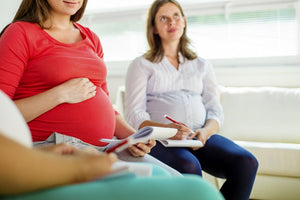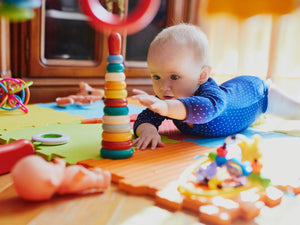Key Points:
- Bottle propping increases risks of ear infections, choking, aspiration of milk into the lungs, and suffocation from the objects used to prop the bottle.
- Prop feeding can lead to over or underfeeding, affecting a baby's growth and development, and increases the risk of vomiting, choking, and aspiration.
- Milk exposure during prop feeding can cause tooth decay due to prolonged contact with lactose, leading to a condition known as bottle caries.
- Prop feeding misses opportunities for emotional connection during feeding times, crucial for a baby's brain development and parent-child bonding.
Many parents have heard of bottle propping, also known as prop feeding. And most of us have seen babies sucking quietly away on their own.
What’s bottle propping or prop feeding?
Bottle propping is when, instead of the baby being held to drink their bottle, they are on their own. The bottle is supported by a pillow or blanket, even a soft toy so that it’s angled with the milk filling the neck of the bottle and the teat. The baby lies in their cot/pram/on the floor sucking away on their own.
What’s so wrong with it?
The problem with propping a baby’s bottle is that it’s risky in all sorts of ways. And although it can be an easy, time saving thing to do, prop feeding is never safe and can cause a range of health issues.
Bottle propping increases the risk of
Ear infections
Babies who suck when they’re lying flat are at risk of getting ear infections. This is because the milk pools in their Eustachian tubes – the small tube which runs from their nose to their ear. Babies should never lie completely flat when they are feeding.
Bacteria multiply in the milk at the back of the baby’s throat and can travel the very short distance into their Eustachian tubes. Ear infections increase the risk of hearing loss which, left untreated, can cause delays in children learning how to speak.
Choking
Choking is a risk as the baby can’t control the flow of milk. Instead of a parent supervising how the baby is sucking and swallowing, the milk just keeps flowing, even if the baby isn’t ready to suck/swallow again.
Choking can be silent and unless someone is close enough to see the baby struggling, choking may not even be detected.
Aspiration of milk
With prop feeding, instead of the milk going into the baby’s stomach, it can go into their airway and lungs. A contributing factor is that the baby is lying flat when they feed, instead of being more upright or at an angle in their parent’s arms.
Chest infections and hospitalisation are more common in babies who prop feed.
Suffocation
Pillows, blankets, soft toys, rolled up bed linen – these are all commonly used to angle and support the bottle, and all pose a suffocation risk.
Babies are safest when there is no risk of bed linen or other items which could cover their face and cause smothering. Check here to make sure you’re following the safe sleeping guidelines which need to be followed at all times.
Over or under feeding
Parents need to monitor the amount of milk their baby drinks, otherwise there’s a risk the baby could drink too much or too little. Eventually, either of these issues can cause problems with the baby’s growth and development.
Babies give clear cues or signals when they’re still hungry or have had enough to drink. They turn away from the bottle, start fussing and let the teat fall out of their mouth when they’re being held. Young babies especially, don’t have the head control to move away from the teat if they’re prop feeding, if it’s positioned so they have no choice but to keep sucking.
Vomiting and choking is more common in babies who are prop fed and this also leads to a higher risk of aspiration – milk going into their lungs.
Tooth decay
Milk contains lactose, a type of sugar. When babies prop feed, their teeth are exposed to milk for a longer period than when they are fed in a parent’s arms. Babies teeth are more prone to decay than adult teeth are and it’s important to limit their exposure to milk and solid foods which can lead to decay.
Milk + bacteria = acid and it’s this combination which causes decay. There is a condition called bottle caries which is entirely preventable and helped by ceasing all bottles from around 12 months of age.
Missed opportunity for emotional connection
Feeding is a special time and an opportunity for communication and affection. Over the course of a baby’s life, hours are spent during feeding times. Prop feeding doesn’t allow for as much time for babies to connect with their parents.
Cuddling, eye contact, gentle touch and communication are all missed when a baby is prop fed. Brain development is supported when babies feed in their parent’s arms, especially in the important areas of social and emotional connection.
Safety Tips When Bottle Feeding
- Check the temperature of the milk on your forearm. It should be comfortably warm, not hot or cold.
- Make sure you prepare the formula exactly as the manufacturers recommend.
- Always hold your baby when they’re drinking their bottle. Never leave them alone.
- Hold your baby close to you so they feel safe and secure.
- Follow your baby’s lead and be sensitive to their cues which will let you know what they want. Remember, your job is to prepare and offer the bottle, how much they drink is their choice.
- Most babies know when they’re hungry or full and give cues either way.
Top Five Bottle Feeding Tips
- Make sure the flow of the milk through the teat whole is a comfortable rate for your baby. Too fast and they will feed too quickly, too slow and they’ll get frustrated. An average feeding time is around 20-30 minutes.
- The cost of bottles/teats is not always a reflection of their quality. Babies develop individual preferences and sometimes the cheaper options work out best.
- If a bottle or teat is damaged, throw it away. Don’t try and save money by reusing bottles for babies.
- Don’t heat milk in the microwave. This can lead to uneven heat distribution and burning. Instead, place the bottle of milk in a jug or container of hot water until it’s warm.
- Mix the formula powder and water just before offering it to your baby.
And another thing…
Sometimes change the way you position your baby in your arms when feeding them. Hold the bottle in your non-dominant hand and position your baby in the opposite arm to the one you usually hold them in. Doing this may help your baby’s visual development.
Written for Nourish by Jane Barry Midwife and Child Health Nurse.
Our Products
-

01. Guide to a Healthy Pregnancy
$55 -

02. Positive Birthing Course
$55 -

03. Infant Feeding Guide
$55 -

04. Baby Sleep Guide - First 12 Months
$55 -

05. Toddler Parenting Course 1 - 3 Years
$55
-
 When to Start Antenatal Classes?
When to Start Antenatal Classes?
Becoming a parent is an incredible milestone, but it comes with a host of changes that can be daunting, especially for first time parents. Antenatal classes are all about offering expectant parents the education they need to make informed decisions, look after their bodies and care for their newborn babies. While you probably already have a long list of things you need to accomplish during your pregnancy, it’s a good idea to make time to attend antenatal classes.
-
 Development Milestones 4-8 Months
Development Milestones 4-8 Months
As they reach the middle of their first year, you'll start to see bigger leaps in their growth and ability!
In this article, we’re going to discuss your baby’s developmental milestones between 4-8 months, and what you can expect along the way.






 When to Start Antenatal Classes?
When to Start Antenatal Classes?
 Development Milestones 4-8 Months
Development Milestones 4-8 Months








